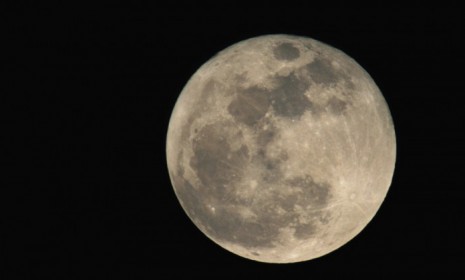Why is the Moon shrinking?
The Moon is getting smaller, say scientists, as evidenced by stretch mark-like ridges on its surface

The Earth's celestial companion is shrinking, a group of U.S. astronomers announced on Thursday. The moon is now significantly smaller than it was at the beginning of its lifecycle, prompting new theories about its past — and its future: (Watch a report about the shrinking Moon)
How do astronomers know the moon is shrinking?
They found the lunar equivalent of stretch marks — long, winding ridges called "lobate scarps" — scattered across the moon's surface. The scientists think the scarps are formed by the moon's crust buckling over its shrinking, cooling molten core. It's similar to "the wrinkles that form on an old apple as it dehydrates and shrinks," says Ian O'Neill in Discovery News.
The Week
Escape your echo chamber. Get the facts behind the news, plus analysis from multiple perspectives.

Sign up for The Week's Free Newsletters
From our morning news briefing to a weekly Good News Newsletter, get the best of The Week delivered directly to your inbox.
From our morning news briefing to a weekly Good News Newsletter, get the best of The Week delivered directly to your inbox.
How much has it shrunk?
About 600 feet in diameter — roughly the length of two football fields — in the last billion years. This is a surprising development, given that the moon is thought to be 4.5 billion years old.
Could the moon disappear?
No."The moon may be shrinking, but not by much. It's not going anywhere," says lead researcher Thomas Watters of the Smithsonian's Center for Earth and Planetary Studies. To date, the moon — diameter: 2,160 miles — has diminished in size by about 0.003 percent. And since the cooling is slowing down, so will future shrinkage.
A free daily email with the biggest news stories of the day – and the best features from TheWeek.com
Then why is this big news?
This "blockbuster" finding proves that the moon's molten core, previously thought to be long dead, may still be geologically active. "It was thought to be dead and unchanging," says Michael Wargo, NASA's chief lunar scientist. "This isn't your grandfather's moon anymore."
What can we learn about the moon from this?
It doesn't change our theory of how the moon was formed — from the molten debris when an asteroid hit the still-forming Earth — but the possibility that its core is still active could give scientists more clues as to how it evolved. Mostly, though, scientists are excited because this discovery means that "despite it being perhaps the most well-studied object in the sky, our moon is still capable of surprising us," says Phil Plait in Discover, and "some of its secrets are actually rather big."
Sources: National Geographic, Guardian, Christian Science Monitor, San Francisco Chronicle, New York Times, Discover, Discovery News
-
 Political cartoons for December 13
Political cartoons for December 13Cartoons Saturday's political cartoons include saving healthcare, the affordability crisis, and more
-
 Farage’s £9m windfall: will it smooth his path to power?
Farage’s £9m windfall: will it smooth his path to power?In Depth The record donation has come amidst rumours of collaboration with the Conservatives and allegations of racism in Farage's school days
-
 The issue dividing Israel: ultra-Orthodox draft dodgers
The issue dividing Israel: ultra-Orthodox draft dodgersIn the Spotlight A new bill has solidified the community’s ‘draft evasion’ stance, with this issue becoming the country’s ‘greatest internal security threat’